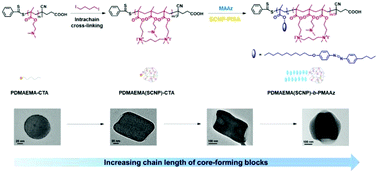Influence of single chain nanoparticle stabilizers on polymerization induced hierarchical self-assembly†
Abstract
Polymerization induced hierarchical self-assembly (PIHSA) has been developed as a facile and robust method to prepare non-spherical polymer nanoparticles at high solid content. But the current PIHSA formulations are limited to linear liquid crystalline (LC) block copolymers (BCPs). Besides, the non-spherical morphology library is desired to be enriched for more morphology-dependent applications. In this work, intramolecularly folded single chain nanoparticles (SCNPs) with steric character are used as stabilizers to construct reversible addition–fragmentation chain transfer (RAFT) dispersion PIHSA formulation for the first time. The study of the polymerization kinetics illustrates the controlled characteristic. The influence of SCNP stabilizers on the self-assembly behavior is investigated in detail by tuning the polymerization degree of core-forming blocks, solid contents, and intrachain cross-linking degree of the SCNPs. The results suggest that the morphology evolution is significantly affected by the architecture of the SCNP stabilizers. Under the synergistic effect of the steric architecture of the outside SCNP stabilizers and internal LC ordering, a unique morphology evolution of sphere–cuboid–holbrick–jujube, rather than typical sphere to one-dimensional morphology, was observed. This work provides a facile route to polymeric nanoparticles with unique non-spherical morphologies and demonstrates that introducing SCNP into polymerization induced self-assembly formulation is a promising approach for morphological control.



 Please wait while we load your content...
Please wait while we load your content...